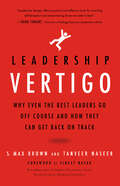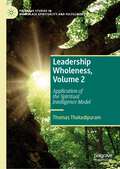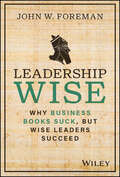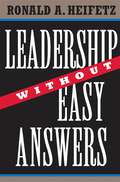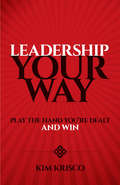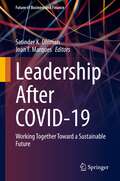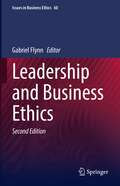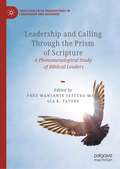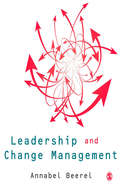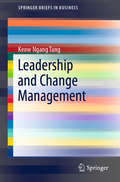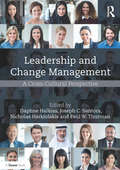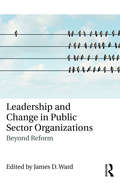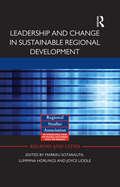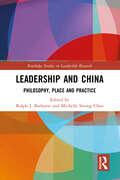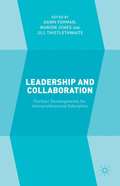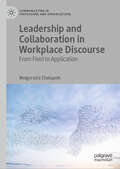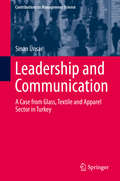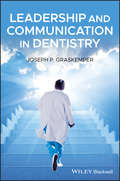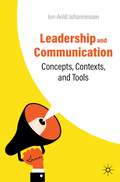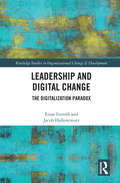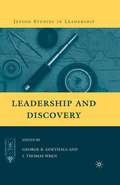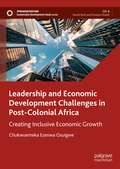- Table View
- List View
Leadership Vertigo: Why Even the Best Leaders Go Off Course and How They Can Get Back On Track
by S. Max Brown Tanveer NaseerOver the past few decades, there's been an exponential rise in the number of books and studies on leadership and what we need to do to ensure organizational success in today's increasingly complex and interconnected global market. And yet, we continue to see year after year research that shows employee engagement and morale levels plateauing on the low end of the scale. Why is this? Why are we unable to move the needle and create the kind of working conditions that not only allow our employees to succeed, but thrive under our leadership? What these findings reveal is that leaders often can't see the gap that exists between what they want their leadership to represent and how others actually experience their leadership. Many of us are experiencing a common perceptual problem where our brain sends us false signals assuring us that everything is okay when it is not. We call this phenomenon Leadership Vertigo. Leadership Vertigo: Why We All Go Off Course and How We Can Get Back on Track will help you to understand how you can counter these bouts of self-deception by employing four Leadership Landmarks, Community, Competence, Credibility, and Compassion, to get your team back on course.
Leadership Wholeness, Volume 1: A Model of Spiritual Intelligence (Palgrave Studies in Workplace Spirituality and Fulfillment)
by Thomas ThakadipuramThis book investigates the lived experience of CEOs in their quest for wholeness and presents a model of spiritual intelligence for contemporary leadership. The experience of ethical and spiritual crisis in the post-modern society especially in organizational leadership, calls for deeper quest and spiritual intelligence. Four essential themes emerged from the analysis of the in-depth interviews with top leaders of different organizations across the globe: (1) Sensing Crisis, (2) Embracing Crisis (3) Awakening Hidden Wholeness, (4) and Serving Greater Good. From the analysis of the themes, a model of spiritual intelligence and leadership wholeness is constructed. This Spiritual Intelligence Model portrays the intra-dynamics of leaders’ ongoing quest for wholeness penetrating through their existential, learning, spiritual, and moral dimensions of being and the five ethical dimensions of wholeness permeating through the personal, organizational, social, global, and environmental spheres of life. This book gives a fresh perspective on spiritual intelligence and leadership practice today.
Leadership Wholeness, Volume 2: Application of the Spiritual Intelligence Model (Palgrave Studies in Workplace Spirituality and Fulfillment)
by Thomas ThakadipuramThis book explores the application of wholeness and spiritual intelligence model in leadership and management today. The classical and contemporary perspectives on wholeness and spiritual intelligence provides the research basis for the spiritual intelligence model. From a pragmatic perspective, the integration of the nature of evil and its impact on spiritual intelligence is examined. This book gives fresh perspectives on leadership and management practice today
Leadership Wise: Why Business Books Suck, but Wise Leaders Succeed
by John W. ForemanWhy do so many business books feel useless the moment they come in contact with your day job? Business books often contradict one another, each providing advice that's only helpful some of the time, and exhaustingly, your boss is going to cherry pick only the books that suit their way of working. Additionally, too often leadership books push fundamentally changing your personality to look like some idealized leader, often some dude. That dude may not even be a business leader! They might be a marine, a mountain climber, or a politician. Their stories might inspire you to summit Everest, but they're not going to help you figure out the looming company merger or what to do with that struggling manager In Leadership Wise, Chief Product Officer at Podium, John Foreman, delivers a different and refreshingly practical take on business leadership. The author moves beyond what a leader should look like, to discuss how you can make better decisions over time to help your organization accomplish its goals. Regardless of a reader's personality and background, John provides practical advice for how anyone can become a great leader just as they are by making more effective decisions over and over again. It's not about becoming a 5-star general or a mythical titan of industry, it's about making better decisions more often. In the book you'll find: A structure for understanding and becoming comfortable with the unending contradictions of leading in business Strategies for defining priorities, sourcing options, and choosing the best decision Advice for channeling your emotions and company culture to more effectively solve problems An engaging and hands-on exploration of how to lead real people in real companies by making the best decisions possible with the information you have, Leadership Wise belongs on the desks of managers, executives, directors, entrepreneurs, and founders everywhere.
Leadership Without Easy Answers
by Ronald A. HeifetzDrawing on a dozen years of research among managers, officers, and politicians in the public realm and the private sector, among the nonprofits, and in teaching, Heifetz presents clear, concrete prescriptions for anyone who needs to take the lead in almost any situation, under almost any organizational conditions, no matter who is in charge. His strategy applies not only to people at the top but also to those who must lead without authority--activists as well as presidents, managers as well as workers on the front line.
Leadership Without Easy Answers
by Ronald A. HeifetzDrawing on a dozen years of research among managers, officers, and politicians in the public realm and the private sector, among the nonprofits, and in teaching, Heifetz presents clear, concrete prescriptions for anyone who needs to take the lead in almost any situation, under almost any organizational conditions, no matter who is in charge.
Leadership Your Way: Play the Hand You're Dealt and Win
by Kim Krisco"Krisco shares the ideas that allowed our team to break through the rigid mindsets we've been struggling to change." — Michael Barker, Vice President, Organization Development, Verizon"Leadership Your Way is the playbook for business leaders who are committed to transforming themselves." — Daniel W. McGee, CEO, American Motion Systems, Inc."The 21st century's best leaders will have to read this book — a fistful of useful ideas for futuristic leaders." — Frank Feather, author, The Future Consumer and G-Forces: The 35 Global Forces Restructuring Our FutureLeadership Your Way provides a clear, transformational framework for managers to take advantage of their innate leadership style. Kim Krisco encourages authenticity above all else, rather than operating according to rules which may be more suited for different personality types. He describes four distinct personalities and shows how they apply to ten common leadership initiatives — acts that every successful leader performs.With this book, you'll learn to maximize your leadership style by leveraging your natural strengths, managing your weaker areas, and playing the hand you're dealt. Using numerous case studies, Krisco puts you in touch with your own innate interpersonal style, providing personalized coaching that will enable you to comfortably and naturally put each leadership initiative into play to achieve business success and personal fulfillment.
Leadership after COVID-19: Working Together Toward a Sustainable Future (Future of Business and Finance)
by Satinder K. Dhiman Joan F. MarquesThe COVID-19 pandemic has permanently changed lives around the world and no dimension of life and leadership seems to have been spared from its wrath. It has also stirred us into thinking about novel approaches to lead organizations and societies toward a shared, sustainable future. This book offers novel perspectives on leadership and change management after the COVID-19 pandemic that take us beyond striving for thriving—perspectives that are grounded in emergent theory, research and practice. It highlights sustainable leadership and change management strategies to effectively deal with unpredictable and rapidly changing situations—particularly in a world that is increasingly volatile, uncertain, complex, and ambiguous (VUCA). This book also highlights engaging perspectives by specialists from different disciplines such as business, psychology, education, and health care. It serves as a practical guide in identifying and responding to leadership challenges and opportunities in each of the four VUCA categories of volatility, uncertainty, complexity, and ambiguity—and how they affect businesses, organizations, and societies as a whole.
Leadership and Business Ethics (Issues in Business Ethics #60)
by Gabriel FlynnThis book offers new and challenging approaches to business ethics that successfully link theory and practice thereby overcoming lacunae and inadequacies in much of the literature concerning ethics and governance, a theme that recurs with remarkable frequency in the history of business ethics as an academic discipline. This work provides imaginative and innovate proposals for the indispensable coupling of virtue, integrity, and character with global business, finance, and banking. The volume seeks to overcome the marginal status of business ethics in universities, business, and enterprise by demonstrating that virtue ethics is an important step in the direction of an adequate response to the leadership issue. This new edition of a popular work points to new ways of achieving an ever more urgent coalescence of ethics and business. It proposes practical advice and viable suggestions to business people on what is right and wrong in business. The volume makes a vital contribution in the area of education that should serve the ongoing development of top leaders. In the important domain of women in leadership, the volume provides new solutions that break boundaries on the global stage. The work challenges unethical marketing of human images with important implications for citizenship and society. The volume contains creative suggestions for the use of spirituality and human development for the enhancement of business and society. The significantly extended second edition includes an exciting line up of leading academics and practitioners in the audacious hope that something may change for the better in the realms of business and banking.
Leadership and Calling Through the Prism of Scripture: A Phenomenological Study of Biblical Leaders (Christian Faith Perspectives in Leadership and Business)
by Fred Wantante Settuba-Male Gia R. TatoneThis volume offers phenomenological studies that examine the lived experiences of biblical leaders, emphasizing external summons and a prosocial intention while offering suggestions for future research. Part 1 focuses on various aspects of divine calling and leadership, covering topics such as the calling of biblical prophets like Jeremiah and Samuel, and the downfall of Solomon. Part 2 explores successful biblical leadership and followership from a qualitative, phenomenological lens, analyzing the experiences of Abraham, Paul, and Samson. Part 3 presents both positive and negative portrayals of biblical leadership, demonstrating how both types can lead to social justice outcomes.Presenting a Christian perspective of the relationship between the leaders and their sense of calling, this book employs a phenomenological approach to investigate the significance of various aspects of God’s calling, such as the leader’s discernment of the calling, predictors of a leader’s calling, the social- cultural influences of the calling, the relationship between personality traits and calling, and the evolution of a leader’s calling. This book will contribute to scholarly discussions related to meaningful work, workplace satisfaction, employee engagement, and responsible leadership.
Leadership and Change Management
by Annabel BeerelRecognizing and responding to change is the oxygen of life for an organization, and leadership is fundamentally about focusing organizations on these new realities. Leadership and Change Management provides the reader with a practical, real-world understanding of several dimensions of leadership that are usually neglected in management textbooks, such as the nature of new realities and how managers can improve their insight into them, and how leaders can identify and overcome resistance to change. Drawing on a wide range of insightful, global real-life case studies to capture the imagination, the topics covered include critical systems thinking, philosophies of leadership, group dynamics, authority, ethics, personal character and the psychology of leadership. This comprehensive text will be of interest to anyone looking for a more thoughtful engagement with the key issues in leadership and change management.
Leadership and Change Management (SpringerBriefs in Business)
by Keow Ngang TangThis book offers an insightful guide for academics, managers and practitioners, as well as undergraduate and graduate students of business studies. It focuses on how the theoretical foundations of leadership and change management can be used to effectively lead business organizations. Generally speaking, business leaders are beginning to recognize the important of change and transformation, not only as a means of retaining control, but also of demonstrating their own leadership initiative. Though new approaches, designed to make this task easier, are constantly emerging, in practice managerial change remains a challenge. The book chiefly focuses on the open-social-systems model to provide a conceptual framework that structures and relates leadership theories and research to help business leaders manage change. A wealth of case studies and discussion activities that support the main concepts and theories are also included. The book’s primary goal is to help readers successfully plan and manage change and transformation. Tertiary education students who are taking business studies courses can also use it as a sourcebook for the principles of successful change management.
Leadership and Change Management: A Cross-Cultural Perspective
by Nicholas Harkiolakis Daphne Halkias Joseph C. Santora Paul W. ThurmanA leader’s role in the management of change is a critical issue for successful outcomes of strategic initiatives. Globalization and economic instability have prompted an increase in organizational changes related to downsizing and restructuring in order to improve financial performance and organizational competitiveness. Researchers agree that a leader’s inability to fully understand what is needed in order to guide their organization through successful change can be a reason for failure. Proper planning and management of change can reduce the likelihood of failure, promote change effectiveness, and increase employee engagement. Yet, change in organizations must be viewed as a continuous activity that affects both organizational and individual outcomes. If change management can be considered as an event induced by socio-cultural factors, the cultural variable gains greater significance when applied to the quality of the relationship between a leader and their team. Many organizations today are on the verge of internationalization. It is here that the cultural context can affect behaviors and, in the same way, leadership style. The research presented in this book by an eminent group of scholars explores the influence of culture – ethnic, regional, religious – on how leaders manage change within organizations.
Leadership and Change in Public Sector Organizations: Beyond Reform
by James D. WardSuccessful change in the public sector can be supported or hindered by political and administrative leadership, individual and group motivation, and the public’s perception of the effectiveness of public officials and government structures. But do the very characteristics of public sector organizations present obstacles to successful transformative change? This book assesses the current state of the literature on leadership and change in government and public policy, and introduces the reader to innovative new ways to demonstrate leadership in times of change. Contributions from accomplished scholars in the field cover the traditional public administration areas of performance and management, as well as the diversity of issues that surround public leadership and change, both domestic and global. Chapters on public sector innovation, performance leadership, governance networks, complexity in disaster management, change initiatives in educational systems and local government, citizen advisory bodies, and gender and race equality, to name but a few, provide important case studies throughout the volume. Leadership and Change in Public Sector Organizations will be required reading for upper level undergraduate and graduate courses in public administration/management, leadership, and public policy analysis.
Leadership and Change in Sustainable Regional Development (Regions and Cities #60)
by Joyce Liddle Markku Sotarauta Lummina HorlingsThis book shows, first of all, that leadership plays a crucial role in reinventing regions and branching out from an old path to something new in order to create more balanced and sustainable regional development. Second, it maintains that leadership is not a solo but a multi-agent and -level activity and that it needs to be discussed and studied as such. Third, as the book argues, leadership is shaped differently in various institutional and cultural contexts and on different scales. This book explores the ways leadership plays our in regional development context contributing to economically, socially and ecologically balanced sustainable future.
Leadership and China: Philosophy, Place and Practice (Routledge Studies in Leadership Research)
by Ralph J. Bathurst Michelle Sitong ChenSince its opening in 1978, China has undergone radical change. By establishing special economic zones along its Eastern coastal borders under Deng Xioping’s tutelage, China entered the global market. Loosening controls from central government allowed for a more free-market approach that facilitated easier trading partnerships across national boundaries. Leadership and China: Philosophy, Place and Practice explores the impact of these changes today. Companies across the globe are doing business with Chinese counterparts, but recently the Western world has begun treating China with suspicion, with some commentators claiming nefarious aims on the part of Chinese Communist Party, and intentions of favoring China’s growing middle class and political elites, while impoverishing other international trading partners. This calls for wise leadership on both sides of the political divide and this book facilitates conversations that explore synergies between East and West, aiming to move past suspicion and discuss how leaders might work for the benefit of all humanity. With an orientation towards conversations rather than polemics, graduate students, scholars and business leaders across the globe will benefit from this book.
Leadership and Collaboration
by Marion Jones Jill Thistlethwaite Dawn FormanLeadership and Collaboration provides international examples of how leadership of interprofessional education and practice has developed in various countries and examines how interprofessional education and collaborative practice can make a difference to the care of the patient, client and community. The authors showcase a variety of contexts in which interprofessional education and practice is now taking place and provide guidance for leaders to establish and maintain an environment where everyone involved in the team can 'learn with, from and about each other to improve collaboration and the quality of care".
Leadership and Collaboration in Workplace Discourse: From Field to Application (Communicating in Professions and Organizations)
by Małgorzata ChałupnikThis book presents a comprehensive examination of how leadership and collaboration are discursively performed in professional communication, using real-world data from a UK public sector IT team. Taking an auto-ethnographic approach to workplace talk, the author examines the language involved in the performance of different team-based professional roles, examining how professional identity and relationships are indexed through casual face-to-face talk in an office environment. This investigation of how a group of people come together in an effort to achieve shared workplace goals relates to key debates in the area of professional communication, putting forward new theoretical and methodological frameworks for understanding and analysing how person-orientated aspects of professional communication shape discourses of work. This book appeals to a wide and interdisciplinary audience, including advanced undergraduate and postgraduate students, academics and researchers specialising in applied linguistics broadly, and professional communication in particular, as well as consultants and practitioners working across a wide range of professional sectors.
Leadership and Communication
by Sinan ÜnsarThis book deals with the concepts of leadership and communication in business organizations, initially on a general level and then in detail through an analysis of specific cases. First the book provides a contextual framework to explain the role and importance of the topic. The foundation is provided by selected behavioural and situational theories. Then 15 different leadership models and their respective communication strategies are specified. The interaction of leadership and communication is examined explaining organizational communication and its tools. In the third part the book looks in detail at the glass, textile and confection industries. It examines the relationship between socio-demographic variables of employees, leadership types and communication styles and systems of managers in these sectors. The results of this study provide researchers and professionals with a number of suggestions for more effective organizational communication and better leadership practice.
Leadership and Communication in Dentistry
by Joseph P. GraskemperThis book provides practical strategies for dentists to effectively and confidently communicate with many dental insurance issues, as well as with their patients and members of their staff. Providing real-world examples and sample letters, the book includes specific guidance on how to handle common communication scenarios to avoid being caught off-guard or unprepared. Leadership and Communication in Dentistry begins with a unique section discussing communications with insurance companies, including negotiations, PPO contract issues, appeals letters, and more. It then includes chapters on communicating with patients, addressing how to listen to their concerns and motivate them, and staff, emphasizing how to be a better leader and institute office policies. The final section explores how dentists can use leadership and communication skills to improve their practice of dentistry. Provides concrete guidance on how dentists can confidently take the lead on conversations with dental insurance companies, their staff, and their patients Includes real-world examples of how to lead through communications Divided into sections covering communications with insurance companies, dental patients, and staff members Teaches that being mindful of proper communication and leadership skills will create a true balance for the successful dentist leader to become successful at living Leadership and Communication in Dentistry is a must-have resource for any dentist or dental student wishing to improve their communication skills.
Leadership and Communication: Concepts, Contexts, and Tools
by Jon-Arild JohannessenManagers and leaders spend a great deal of time on communication; it binds together all the communications in the organisational system. In other words, communication is the glue that impacts on the effectiveness of communication in the entire organization, therefore the style of leadership communication has a profound impact on how the organization works. If too much ‘glue’ is used, the consequence is information overload, which hampers effective communication. If there is too little glue, individuals and entire organizations may find themselves in a pathological state of disorder, with people filling the information vacuum with rumours and gossip. Leadership communication can be involving and participatory, motivating colleagues to be creative and put in as much extra effort as is necessary. Leadership communication can also be power-based and patronizing. Such a style of communication will cause tensions and conflicts within an organization. In this textbook, the author shows how information and communication are parts of a special type of interaction, namely situations in which you want to gain trust or influence people. With a plethora of case examples and practical exercises to get stuck into, this engaging book helps students gain a deeper understanding of the concepts and contexts described in each chapter, such as communication strategies, influencing techniques, communication and values, and communication and trust. The second half of the book offers six personal communication tools, and six personal coaching tools, with assignment to each of the coaching tools. In addition, the book provides 66 exercises to the six personal communication tools. Ideal reading for those taking leadership and communication courses, this textbook takes a practical approach to the key issues in organizational communication that will prepare students for their careers in business.
Leadership and Cultural Context: A Theoretical and Empirical Examination Based on Project GLOBE
by Jon Paul Howell Mansour Javidan Peter W. Dorfman Paul J. HangesLeadership today involves fewer and fewer borders as global corporations fashion their strategies around integrating production and delivering value worldwide. Transforming a global organization to a global network of interconnected and integrated operations is no easy task. From a leadership perspective, it requires the ability to work with and influence individuals of diverse cultural backgrounds, both inside and outside the corporation, to help achieve corporate goals. In this chapter, the authors raise crucial issues about the nature and dynamics of leadership in a cross-cultural environment. The foundation of their approach is the notion that organizations and societies have implicit leadership theories, with distinct beliefs about the attributes that define effective leadership. These beliefs, in turn, shape individuals' perceptions about who is and who is not a leader. Taking an integrative and multilevel approach, the authors examine the impact of both national culture and organizational culture on implicit leadership attributes. They present a series of hypotheses on the relationship between specific cultural dimensions and specific leadership attributes, using the worldwide GLOBE database of outstanding leadership dimensions to test these hypotheses and present their conclusions. This chapter was originally published as Chapter 13 of "Handbook of Leadership Theory and Practice: A Harvard Business School Centennial Colloquium."
Leadership and Digital Change: The Digitalization Paradox (Routledge Studies in Organizational Change & Development)
by Einar Iveroth Jacob HallencreutzDigitalization is on everyone’s lips as new technology changes business landscapes and conventional companies are outperformed by younger digital and agile contestants. In this volatile environment it seems more relevant than ever before to understand the aspects and business logic behind the elusive phenomenon called "digitalization". Never before have there been such great opportunities to unleash the full potential of technology within organizations to create long-standing competitive advantage. This book explains the strategy and practice of how to lead and control the people side of digital change in a dynamic world of uncertainty and social complexity, and as such the book snares the elusive phenomena of digitalization Digitalization drives behavioral change and calls for a new way of thinking among senior executives. In practice, reaping the benefits of digital technology is not as easy as it first appears to be. This book provides a map to navigate in the volatile business landscape where change occurs continuously because of digital technology. It provides an historical frame of the evolution of digital technology, decodes digitalization’s negative influence on the external aspects of customer satisfaction, discusses and explains the strategic and leadership consequences of different forms of digital change, and finally demonstrates how leading digital change can be put into practice. Illustrative case studies and examples are provided throughout as well as models and frameworks. This is a valuable resource for researchers, academics, and students in the fields of organizational studies, organizational change, technology and innovation management, and digitalization.
Leadership and Discovery
by J. Thomas Wren George R. GoethalsThis book, a collection of essays from scholars across disciplines, explores leadership of discovery, probing the guided and collaborative exploration and interpretation of the experience of our inner thoughts and feelings, and of our external worlds.
Leadership and Economic Development Challenges in Post-Colonial Africa: Creating Inclusive Economic Growth (Sustainable Development Goals Series)
by Chukwuemeka Ezenwa OsuigweThis book explores the economic and development challenges seen within post-colonial Africa. Particular attention is given to governance and political leadership challenges within Africa and how they have resulted in poor education facilities, a lack of infrastructure development, corruption, and economic insecurity. The ways in which Africa’s natural resources and agricultural land have not been utilised to drive development and economic growth are examined in relation to internal political conflicts. Broader issues, such as labour exploitation, financial leakage, and the exclusion of women from decision making, are also discussed. This book highlights poor political leadership within Africa and presents a framework for inclusive economic growth within post-colonial Africa. It will be of interest to students, researchers, policymakers and leaders working with development of African economics.
